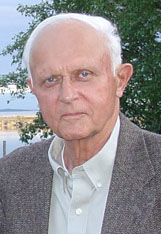John Blinks, The Right Man for the Place and Time
By Dennis Willows, Ph.D.
In the early 1960's, although people in biomedical science were beginning to make sense of the roles of DNA, RNA and protein in building and controlling all living creatures, there was still mystery about how muscle contracted. Think of it….. cells, tiny bags of chemicals, that not only could twitch and change their shape, did so when commanded by millisecond pulses from nerves, and in the case of heart muscle, did it over and over and over, absolutely on their own, even in a Petri dish!
There were a lot of ideas about how the twitching and shortening of muscle cells actually happened, and there was some urgency about sorting out the alternatives. From the perspective of human heart muscle, there are serious consequences when the strength and coordination of heart muscle cells are impaired.
John Blinks recognized then, along with others in the field, that calcium ions were on the short list of suspects to be controlling this process. To make a long story short, John knew that it was crucial to know in a quantitative way how much ionic calcium was present inside muscle cells during a muscle contraction and why it changed. He also knew that the recently discovered jellyfish light producing protein, aequorin was likely one of the keys to the answers. Fortunately for all of us, he bent himself to the sometimes numbing task of capturing tens of thousands of jellyfish, chemically purifying their photoproteins, and then using them to learn crucial details of the timing and intensity of the interactions of ionic calcium with heart muscle proteins.
We now understand far better how this process works. Drugs that regulate how calcium ions get into muscle cells have been developed and they dramatically improve the quality of life for many people.
When a topic of medical importance becomes "hot" with anticipated discovery, the field sometimes attracts a lot of people. There is then a special need for precision, caution, and disinterest in the flashy elements of progress. There needs to be "an adult in the room". But although many people contributed to the understanding of how cardiac muscle works, John played a uniquely helpful role by elements of his character. He was persistent, thorough, and especially careful not to wander beyond the limits of deduction. John was the right person for the place and time ….. profoundly honest, with his eyes on the prize.
Even beyond our 45 year personal friendship, John is one of my scientific heroes because of his immense impact on physiological science and on the FHL people with whom he worked.
John's family has requested that memorial contributions be made to the Anne Hof Blinks Endowment at Friday Harbor Laboratories.

